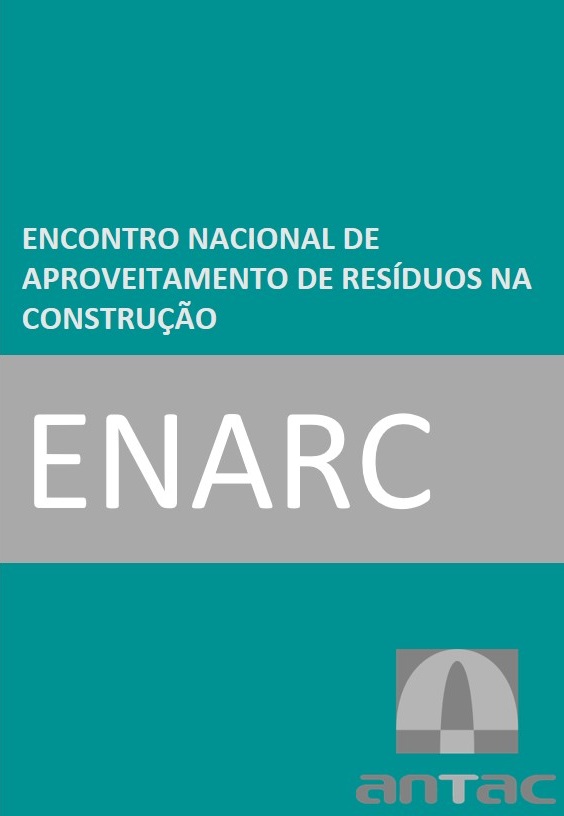Study of structural mortars with the addition of silica fume from steel waste dosed by particle packing
DOI:
https://doi.org/10.46421/enarc.v8i00.2910Keywords:
Sílica fume, Steel waste, Structural mortars, High performance mortars, Cement composites with wasteAbstract
The insertion of silica fume, from steelworks residues, was evaluated on the mechanical, physical, durability and microstructure properties of a high-performance structural mortar. The mortars mixtures was elaborated through the packaging of particles. The following mortar properties were evaluated: compressive and flexural strength, water absorption by capillarity and by immersion, porosity, dynamic modulus of elasticity, electrical resistivity, thermogravimetry and scanning electron microscopy. The mechanical, physical and durability properties were more influenced at early ages by cement and at older ages by silica fume. Dosing by particle packing promoted greater matrix densification, increasing mechanical properties and extending durability, enabling the generation of high-performance mortars. It is concluded that silica fume influences the evolution of the analyzed properties and needs to be considered in the development of high performance mortar mixtures.
References
ALMADA, B. S.; Silva Neto, G. A.; Prado, D. F.; Aguilar, M. T. P.; Garcia, D. C. S.; Silva, G. J. B.; Santos W. J. Evaluation of the microstructure and micromechanics properties of structural mortars with addition of iron ore tailings. Journal of Building Engineering. v. 63, n. A, 105405. ISSN 2352-7102. 2023. Doi. https://doi.org/10.1016/j.jobe.2022.105405.
ASSOCIAÇÃO BRASILEIRA DE NORMAS TÉCNICAS: ABNT NBR 9204: Concreto endurecido — Determinação da resistividade elétrico-volumétrica — Método de ensaio, Rio de Janeiro, 2012.
ASSOCIAÇÃO BRASILEIRA DE NORMAS TÉCNICAS: ABNT NBR 9779: Cimento Portland – Determinação da resistência à compressão, Rio de Janeiro, 2012.
ASSOCIAÇÃO BRASILEIRA DE NORMAS TÉCNICAS: ABNT NBR 9778: Argamassa e concreto endurecidos – Determinação da absorção de água, índice de vazios e massa específica, Rio de Janeiro, 2005.
ASSOCIAÇÃO BRASILEIRA DE NORMAS TÉCNICAS: ABNT NBR 13276: Argamassa para assentamento e revestimento de paredes e tetos ― Determinação do índice de consistência, Rio de Janeiro, 2016.
ASSOCIAÇÃO BRASILEIRA DE NORMAS TÉCNICAS: ABNT NBR 10007: Amostragem de Resíduos sólidos – Rio de janeiro, 2004.
AMERICAN SOCIETY FOR TESTING AND MATERIALS: ASTM C215-19: Standard Test Method for Fundamental Transverse, Longitudinal, and Torsional Resonant Frequencies of Concrete Specimens, ASTM International, West Conshohocken, PA, 2019.
BALESTRA, C. E. T., et al. Evaluation of chloride ion penetration through concrete surface electrical resistivity of field naturally degraded structures present in marine environment. Construction and Building Materials, 230, 116979. 2020. Doi: https://doi.org/10.1016/j.conbuildmat.2019.116979
BHANJA, S.; SENGUPTA, B. Influence of silica fume on the tensile strength of concrete. Cement and Concrete Research, v. 35, n. 4, p. 743–747, 2005. Doi: 10.1016/j.cemconres.2004.05.024
COMITÉ EUROPEU DE NORMALIZAÇÃO: NP EN 12390-3: Ensaio de Concreto Endurecido – Resistência à compressão dos corpos de prova de ensaio, Portugal, 2009.
KHATTAB, R.M.; SADEK, H.E.H.; TAHA, M. A.; EL-RAFEI, A. M. Recycling of silica fume waste in the manufacture of β-eucryptite ceramics. Materials Characterization. v. 171, 110740. 2021. doi: https://doi.org/10.1016/j.matchar.2020.110740.
KIM, Y. H.; JANG, S. H.; KIM, Y. W. Joining of silicon carbide ceramics using a silicon carbide tape. International Journal of Applied Ceramic Technology. v. 93, n. 10. 2010. Doi: https://doi.org/10.1111/j.1551-2916.2010.03867.x.
LOTHENBACH, B.; SCRIVENER, K.; HOOTON, R. D. Supplementary cementitious materials. Cement and Concrete Research, v. 41, n. 12, p. 1244–1256, 2011. Doi: https://doi.org/10.1016/j.cemconres.2010.12.001
MOTAHARI KAREIN, S. M. et al. A new approach for application of silica fume in concrete: Wet granulation. Construction and Building Materials, v. 157, p. 573–581, 2017. Doi: https://doi.org/10.1016/j.conbuildmat.2017.09.132
PINTO, F. B. et al. Mixture design for self-compacting concrete using a virtual particle packing method Projeto de mistura para concreto autocompactante usando um método de embalagem virtual de partículas. Brazilian Journal of Development, v. 7, n. 5, p. 50029–50049, May, 2021. Doi: https://doi.org/10.34117/bjdv7n5-415
ROSTAMI, M.; BEHFARNIA, K. The effect of silica fume on durability of alkali activated slag concrete. Construction and Building Materials, v. 134, p. 262–268, 2017. Doi: https://doi.org/10.1016/j.conbuildmat.2016.12.072
SAHOO, K. K.; SARKAR, P.; DAVIS, R. Mechanical properties of silica fume concrete designed as per construction practice. Proceedings of Institution of Civil Engineers: Construction Materials, v. 172, n. 1, p. 20–28, 2019. Doi: https://doi.org/10.1680/jcoma.16.00085
SIDDIQUE, R.; CHAHAL, N. Use of silicon and ferrosilicon industry by-products (silica fume) in cement paste and mortar. Resources, Conservation and Recycling. v. 55, n. 8, p. 739-744. 2011. Doi: https://doi.org/10.1016/j.resconrec.2011.03.004.
RAUL, B.A.S; MANOEL, M.B.N; VANESSA, A.F.M, B. et al. Aplicação do software EMMA na análise do empacotamento máximo de partículas utilizando o Metacaulim. In: XVII Congresso Internacional sobre patologia e reabilitação de construções, 2021, Fortaleza. v. 1, p. 779–786, 2022. Disponível em: http://doi.editoracubo.com.br/10.4322/CINPAR.2021.098.
WU, Z.; SHI, C.; KHAYAT, K. H. Influence of silica fume content on microstructure development and bond to steel fiber in ultra-high strength cement-based materials (UHSC). Cement and Concrete Composites, v. 71, p. 97–109, 2016. Doi: https://doi.org/10.1016/j.cemconcomp.2016.05.005.

